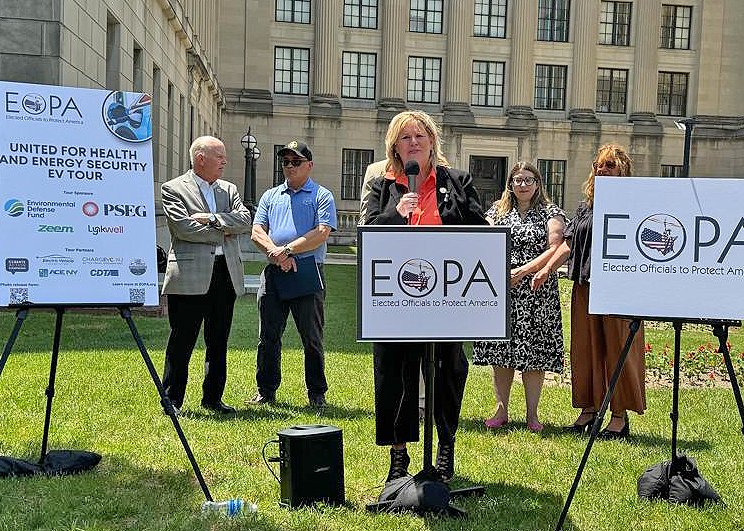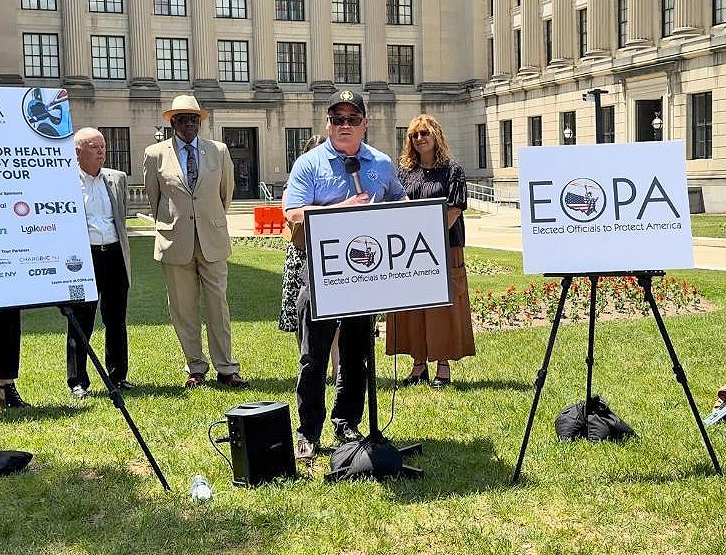On EV tour, lawmakers say, with strong EPA clean car standards, NJ’s transition to EVs will improve health, and help ensure energy security

June 3, 2024
Contact: Ramona Cornell du Houx, EOPA Communication Director
ramona@protectingamerica.net Cell: 207.319.4727
EOPA elected officials United for Health, and Energy Security Electric Vehicle Tour stops at New Jersey State House
TRENTON, NJ While EVs sales continue to increase across America there remain myth barriers that surround EVs. Elected Officials to Protect America (EOPA) is dispelling this false information during their United for Health and Energy Security Electric Vehicle Tour. EOPA’s second tour press event took place at the New Jersey State House today. After the press conference, EOPA held EV demonstrations and took lawmakers for drives on this educational tour.
New Jersey set ambitious climate goals with the Global Warming Response Act to reduce greenhouse gas emissions by 80 percent below 2006 levels by 2050, and Governor Phil Murphy’s Energy Master Plan to achieve 100 percent clean energy by 2050. The Energy Master Plan comprehensively addresses New Jersey’s energy system, including electricity generation, transportation, and buildings, and their associated greenhouse gas emissions and related air pollutants.
“The Environmental Protection Agency’s strong standards reduce greenhouse gas emissions dramatically and put us on the road to universal adoption of EVs. A new era of clean energy electricity is dawning. As we transition to EVs with offshore wind and other clean energy sources powering them, consumers won’t be subjected to fluctuating gas prices,” said Dominic Frongillo, Elected Officials to Protect America Executive Director and Co-Founder, former Council Member and Deputy Supervisor of Caroline, New York. “With federal and state incentives, EVs are affordable. Consumers can currently choose from up to 21 EV models available for less than $35,000. EVs help drive New Jersey’s transition to clean transportation forward for our climate, healthy communities and energy security for generations to come. Electrification is the future we must embrace.”
The transportation sector accounts for approximately 45 percent of NOx emissions in the U.S.; tailpipe pollution contains toxic and harmful compounds that pollute air quality and harm public health. As the new EPA standards reach peak strength, they will achieve a 58 to 70 percent reduction in NOx emissions from MDVs compared to the current standard. Exposure to this air pollution can lead to health problems including increased risk of asthma attacks, strokes, heart attacks, cancer, and premature deaths.
According to Statista, there are about 2.5 million registered cars on the roads in New Jersey. These facts make the EPA’s new vehicle emissions standards critical as a bridge on the road to a zero emissions future.
“On a daily basis the invisible toxic particulates from gas emissions invade the lungs of unsuspecting people just by breathing air. Tragically, environmental justice communities suffer disproportionately the most from these pollutants that can lead to lung and cardiovascular disease, and death,” said State Senator Bob Smith, District 17. “EVs help by cleaning the air. They have zero emissions. Public health will improve, and more jobs in renewable energy like offshore wind and solar will be available as we continue on the highway to power the state with 100 percent clean energy.”
The new EPA standards promote American energy security, averting 14 billion barrels of oil imports by 2055 through reduced gasoline consumption.
“Too many suffer from breathing toxic vehicle emissions. Electrification is our opportunity to reverse this course, bring prosperity and help ensure our energy security as we combat the climate crisis,” said State Senator Patrick J Diegnan, Jr., District 18. “We are on the road to a 100 percent clean energy economy, as long as we keep the EPA clean vehicle standards.”
The fossil fuel industry has neglected public health across the state, and held back clean energy production for too long. The state, nation and world will be positively impacted by the transition to EVs.
“The severe effects of the climate crisis only exacerbate public health problems caused by toxic fossil fuel air pollution, especially in environmental justice communities that are next to highways or near manufacturing and/or shipping facilities,” said Kaleem Shabazz, Atlantic City Council Vice President, EOPA New Jersey Leadership Council member. “Electrification is our opportunity to reverse this course, and help ensure our energy security as we address the climate emergency. EVs powered by never ending offshore wind and other renewable energy sources will move us in the right direction on the road to a clean energy economy where environmental justice can be realized.”

“Electric vehicles are the future, and we must build adequate infrastructure to support this new reality. For a reliable source of power for these EVs and the rest of our infrastructure, we need offshore wind energy . . . ,” said Assemblymember Carol Murphy, District 7. “As a New Jersey lawmaker, I know firsthand that we have a critical once-in-a-generation opportunity for our region to propel forward by becoming a national leader in offshore wind development. Initiatives like these create countless employment opportunities, including thousands of good-paying union jobs. Let’s get to work and save our planet.” Photo by Lauren Urbiztondo.

“Now we need to build public awareness of how EVs are reliable, affordable, and will help save lives while countering the effects of climate change,” said Mayor W. Reed Gusciora, Trenton, EOPA New Jersey Leadership Council. “As we electrify the transportation sector and our buildings, we will need more electricity generated by renewables, especially from offshore wind turbines, which is critical to our success.” Photo by Lauren Urbiztondo.
Governor Murphy set an ambitious goal of registering 330,000 EVs by 2025. As of December 2023, there were 87,000 electric vehicles, and 142,600 Plug-in Hybrid Electric Vehicles registered in New Jersey. In 2012, there were only 338 electric vehicles registered in the state. Additionally, New Jersey is one of 17 states that have California’s strict tailpipe emission standards, and plans to eliminate the sale of new gas-powered vehicles by 2035.
“With our zero-vehicle emissions policy, New Jersey will see $43.6 billion in public health savings, save 3,960 souls from a premature death, and stop 92,400 asthma attacks by 2050, according to an American Lung Association report. Now we need to build public awareness of how EVs are reliable, affordable, and will help save lives while countering the effects of climate change,” said Mayor W. Reed Gusciora, Trenton, EOPA New Jersey Leadership Council. “As we electrify the transportation sector and our buildings, we will need more electricity generated by renewables, especially from offshore wind turbines, which is critical to our success.”
Economic opportunities with more EVs—
Since the passage of the Inflation Reduction Act and Bipartisan Infrastructure Law, announced automaker investments in EV manufacturing have jumped 406 percent, according to the White House.
Offshore wind and other renewable projects bring construction jobs, local tax revenue, and clean electricity that will power the transition to electric vehicles and buildings. Plus, strong ocean winds are reliable around the clock making this resource there all the time.
The Atlantic seaboard has the technical potential to produce more than four times America’s current energy demand with offshore wind energy. Governor Murphy established the state’s offshore wind capacity goal at 11,000 MW by 2040. It gives the state a clear path to meet New Jersey’s mandate to generate half the state’s electricity from renewable sources.
“For a cleaner future for all New Jerseyans and Americans, we must take strong moves towards the technology of tomorrow. Electric vehicles are the future, and we must build adequate infrastructure to support this new reality. For a reliable source of power for these EVs and the rest of our infrastructure, we need offshore wind energy. I’m proud to be part of a bipartisan group of elected officials and civic leaders fighting the climate crisis and driving an agenda to support a growing clean energy economy,” said Assemblymember Carol Murphy, District 7. “As a New Jersey lawmaker, I know firsthand that we have a critical once-in-a-generation opportunity for our region to propel forward by becoming a national leader in offshore wind development. Initiatives like these create countless employment opportunities, including thousands of good-paying union jobs. Let’s get to work and save our planet.”
President Biden successfully passed the Bipartisan Infrastructure Law and the Inflation Reduction Act (IRA).The Inflation Reduction Act EV incentives are up to $7,500, and Charge Up New Jersey promotes clean vehicle adoption by offering incentives of up to $4,000 for the purchase or lease of new, eligible zero-emission vehicles, including battery electric and plug-in hybrid electric These actions put New Jersey and the US on the path to a 100 percent clean energy economy that will improve public health and energy security. As that transition happens, the new EPA clean car standards are critical.
“Lower tailpipe emissions are key as we transition to zero-emission vehicles. They will protect millions who can’t avoid breathing in dirty gas emissions that lead to life-long ailments. In the process, the EPA new standards with more EVs manufactured in the U.S. will spur job creation, economic growth, and family cost savings. Importantly, new EPA standards promote American energy security, averting 14 billion barrels of oil imports by 2055 through reduced gasoline consumption. These strong EPA standards must be upheld,” said Commissioner Balvir Singh, Burlington County, EOPA New Jersey Leadership Council member.
Additionally, the continuation of the Charge Up is in question, yet the program clearly encourages EV purchases. The IRA incentives with Charge Up have increased sales.
Since President Biden took office, companies have announced they will soon invest more than $150 billion in EV and battery manufacturing. Nearly 200,000 jobs have already been added to the economy — most of which were created since the Inflation Reduction Act was signed into law.
“To drive an EV is more than practical — it’s economic wisdom. EV adoption translates into financial savings for drivers and electricity customers coupled with substantial environmental and public health benefits,” said Pam Frank, CEO of ChargEVC New Jersey. “EVs are also 40 percent cheaper to maintain than an internal combustion engine vehicle, according to the Department of Energy. With state and federal tax incentives they’re more affordable than ever before.”
In 2023, a record 1.2 million EVs were bought in the United States, with sales consistently greater each month than in the prior two years. EV interest will continue to grow as consumers gain more familiarity with them, and fast-charging public infrastructure is built out.
The state will receive almost $105 million over five years as part of the National Electric Vehicle Infrastructure initiative. The funding will play a pivotal role in developing and improving sustainable EV infrastructure within the state and is expected to further boost the already positive momentum of EV adoption in New Jersey.
Currently, there are 130,000 EV charging stations across the country, and The Bipartisan Infrastructure Law provides funds for 500,000 more to be installed. There are also incentives in the IRA for home plug in ports. New York state received $175 million from the Bipartisan Infrastructure Law’s $5 billion allocation for EV charging networks. Additionally, companies are providing innovative solutions so that every EV owner can feel safe knowing their EV will find a charging source.
“Clean energy advocacy is vitally important for the advancement of electrified transportation, which in turn benefits our communities and economies. Deploying domestic EV charging hardware and software solutions, like those we produce at Livingston Energy Group, a Lynkwell company, is an effective way to create clean energy jobs, build energy independence and foster sustainable economic growth,” said Kate Kruk, director of partnership and engagement for Livingston Energy Group, a Lynkwell company. “As an approved vendor of EV charging solutions for the State of New Jersey, Livingston Energy Group is uniquely positioned to support the state’s surge in EV adoption. Investing in U.S.-based technology and charging solutions will not only support the expansion of New Jersey’s charging infrastructure but also contribute to the resilience and prosperity of its communities.”
Livingston Energy Group, a Lynkwell company, is a full deployment electric vehicle charging solutions provider that has close to 10,000 charging stations active and in development on its cloud-based software platform, which hosts dozens of EV charging networks.
Previously the tour stopped in New York. After New Jersey the tour continues on to Pennsylvania and Georgia.
The tour is led by Elected Officials to Protect America. EOPA partners for the tour include Climate Action Campaign, National Electric Vehicle Association, Alliance for Clean Energy New York, Charge EVC, Lightning Clubs of America. The Tour is made possible by Environmental Defense Fund, PSG&E, Zeem, and Lynkwell.

An EV demonstration at the EOPA Health and Energy Security Tour at the Trenton Capitol, NJ, where lawmakers were able to test drive EVs. Photo by Duncan McNelis

An EV demonstration at the EOPA Health and Energy Security Tour at the Trenton Capitol, NJ, where lawmakers were able to test drive EVs. Photo by Duncan McNelis